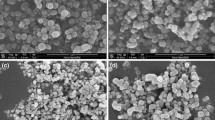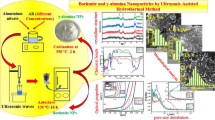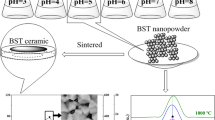Abstract
In this work, we have studied the influence of the pH on the synthesis and structural properties of the Ba0.77Ca0.23TiO3 nanopowders synthesized by a modified polymeric precursor method, in order to achieve non-agglomerated powders. Synthesis, morphology, thermal reactions, crystallite and average particle size of the synthesized powders were investigated through thermal analysis (DTA/TG), X-ray diffraction (XRD), field emission scanning electron microscope (FE-SEM) and Infrared spectroscopy. In summary, Ba0.77Ca0.23TiO3 nanopowders were synthesized for the first time at a relative low temperature (500 °C). It was also found that the alkalinity and acidity of the solution presented a great influence on the powder properties. The best results were obtained from solutions with pH = 8.5 and 11 whose nanopowders presented weakly agglomerate, with homogeneous particle size and a narrow size distribution (30–40 nm). This behavior could be explained based on the FT-IR results in which it was possible to see the increased of the chelation in higher pHs.
Similar content being viewed by others
1 Introduction
Barium calcium titanate is a ferroelectric material at room temperature (point group 4 mm) in which the Ba0.77Ca0.23TiO3 (BCT) composition is the only congruently melting compound 1. BCT ceramics have been reported as a promising multi-layer ceramic capacitor (MLCC), whose main advantages are the good dielectric performance on cheap electrode (such as nickel), and the increasing temperature range of the tetragonal phase. The calcium addition also inhibits the formation of the unwanted hexagonal phase of BaTiO3 2. According to Kuper et al. 1, BCT single crystal presents Curie temperature at 98 °C and it does not show any structural transition down to −120 °C. Due to these attractive properties, considerable efforts have been devoted on the preparation and dielectric properties studies of the BCT ceramics.
Several studies have shown that the calcium solubility, microstructure and dielectric properties of the sintered ceramics were strongly influenced by the synthesis method [2–6]. Frequently, barium calcium titanate powders have been synthesized through solid state reaction or chemical coprecipitation methods using BaCO3, CaCO3 and TiO2 precursors [2–4]. Mazon et al. 2 achieved a single BCT crystalline phase by solid state reaction method after calcinations at 1100 °C/4 h, followed by grinding, and finally sintering at 1300 °C for 3 h. Jayanthi and Kutty 5 reported the obtaining of a single crystalline phase up to 50 mol% of CaTiO3 through three different chemical methods with calcination temperature of 1150 °C. However, up to now there are no reports on the synthesis of BCT by the polymeric precursor method.
In recent years, there has been an increase on the interest in nanostructured ceramic materials because their properties are often different, and sometimes, better than the conventional ceramics with coarser grain structures (e.g., sinterability, mechanical and dielectric properties, or superplastic behavior) [7–9]. However, the most common problem in nanopowder sintering has been the elimination of large pores from the green-compact. These pores are created due to the tendency of these nanopowders to form agglomerates during the powder synthesis by chemical methods 9. The pH of the precursor solutions has often been used as an important parameter to control the agglomerate formation and the morphology of the synthesized powders [10–12]. Thus, in this work we have studied the influence of the pH on the synthesis and structural properties of the Ba0.77Ca0.23TiO3 nanopowders obtained by a modified polymeric precursor method. Synthesis, morphology, thermal reactions, crystallite and average particle size of the synthesized powders have been investigated through thermal analysis (DTA/TG), X-ray diffraction (XRD), field emission scanning electron microscope (FE-SEM) and Fourier transform infrared spectroscopy (FTIR).
2 Experimental procedure
Barium calcium titanate solutions were obtained by the modified polymeric precursor method 6. Figure 1 shows the flowchart of the synthesis process. The titanium, barium and calcium solutions were prepared separately, using as precursor materials, titanium isopropoxide (Ti[OCH(CH3)2]4 – Alfa Aesar, 97%), barium acetate (C4H6BaO4 – Synth, 99%) and calcium carbonate (CaCO3 – Alfa Aesar, 99.95%), respectively. The cationic precursors were mixing to the citric acid (CA) previously dissolved in distilled water (0.1 g/ml), at the molar ratio of 1:6 for titanium, and 1:3 for barium and calcium. The resultant solutions were stirred and heated until the complete dissolution of the cations (at 70–80 °C). Following this dissolution, the solutions were mixed with ethylene glycol (EG), at the mass ratio of CA:EG = 60:40 13, in order to promote the citrate polymerization by polyesterification reaction. The (Ba, Ca, Ti) resin was prepared by mixing titanium, barium and calcium solutions stoichiometrically, thus obtaining a colorless and transparent resin. The pH of the resins was adjusted within the range of 1.5 (as-prepared) to 11 by adding ammonium hydroxide, and then heated up to 120–150 °C in order to eliminate the water excess.
Thermal analysis of the dried resins was performed using a simultaneous TG/DTA (STA 409 Netzsch) at a heating rate of 5 °C/min, in a flow of synthetic air (O2/N2 – 1/4), from the room temperature up to 1200 °C. The structural investigation and phase formation were done by powder X-ray diffraction technique in a XRD – Rigaku Rotaflex RU-200B, using Cu Kα radiation. The measurements were carried out at room temperature in the calcined powder, in continuous mode, in the 2θ range between 20 ° to 60 °, and in steps of 0.02 °. The average crystallite sizes were evaluated from the full-width half maximum (FWHM) by using the [1 1 1] reflection from the XRD patterns, through the Scherrer's equation. The quartz (SiO2) FWHM was used as external standard. The morphological characteristics of the calcined powders were analyzed through Field Emission Scanning Electron Microscope (FEG-VP Zeiss Supra 35). IR spectra were recorded with a FT-IR spectrometer (Nicolet Nexus-470) in the range of 600–4000 cm−1 from the dried resins at 80 °C for 48 h.
3 Results and discussion
Some characteristics of the prepared solutions are summarized in Table 1. The 5 resins were kept at room temperature and after 2 months no kind of precipitate was observed. After 12 months, only the solution at pH 1.5 presented a white fluffy precipitate which was again dissolved with a new stirring. The others did not present any kind of precipitate at all. The color change observed in the resins when the pH increases suggests a better complexation of the metallic cations.
The thermal reactions involved in the synthesis process through the polymeric precursor method have been widely discussed in the literature [12–14]. In short, they can be subdivided in dehydration, hydrolysis, condensation, oxidation and combustion reactions. Figure 2(a) and (b) show, respectively, the TG and DTA curves of the dried resin for the BCT_1, BCT_7 and BCT_11 samples. We have subdivided the thermal events in four stages, according to the temperature range. We have also observed a reduction of the temperature in which the thermal events occur when the pH increases (inset in figures).
The first thermal decomposition stage (from the room temperature to ≈220 °C) is attributed to the hydrolysis and condensation reactions. A reduction of ≈80 °C at the onset of loss mass temperature (Fig. 2(a)), and the arising of an endothermic peak at 180 °C (Fig. 2(b)) were observed when the pH increased. These phenomena are related to the acceleration of the condensation reactions whose origin is due to the large amount of hydroxyl groups under alkaline conditions. The second stage (between 220 °C and 400 °C) is mainly attributed to the oxidation and combustion reactions. In the third stage (between 400 °C and 480 °C) the exothermic peak is due to the combustion reactions and the crystalline phase formation. It is important to note, in the last two stages, that the combustion rate increases for the alkaline conditions. We have associated this behavior to the ammonium hydroxide addition and it can be verified by the narrowing of the exothermic peak at about 450 °C (see inset in Fig. 2(b)).The fourth thermal stage (above 480 °C) is characterized by a broad and smooth exothermic band centered at approximately 900 °C (Fig. 2); this event will be discussed afterwards.
Figure 3 shows the XRD pattern of the BCT_9 resin calcined at several temperatures ranging from 400 ° to 800 °C. The powder calcined at 400 °C/5 h presents a broad continuous band, indicating the predominance of the amorphous phase (Fig. 3(A)). Yet, when the resin was calcined at 450 °C for 10 h (Fig. 3(B)), three crystalline phases were observed: (i) BCT 2; (ii) BaCO3 (JPCDS – ICSD – 41-0373); (iii) and an intermediate organic phase containing the metallic ions 12. By increasing the calcination temperature of the resin up to 500 °C and 600 °C for 5 h (Fig. 3(C) and (D), respectively), we observed both the BCT and a small amount of the BaCO3 phases. This last one was favored by the alkalinity of the solution, and it can be seen in full detail in Fig. 4. On the other hand, a single BCT phase was achieved when the resin was calcined at 700 °C and 800 °C for 2 h. These results agree with the information obtained by thermal analysis (Fig. 2) in which the thermal decomposition of the polymer had been completed at approximately 500 °C.
Figure 4 shows the XRD patterns for the BCT powders synthesized at different pHs, and calcined at 500 °C for 5 h. Two distinct behaviors were found according to the pH value: (i) for pH = 1.5 and 3.5, the powders presented only the BCT phase; (ii) and, for pH = 7, 8.5 and 11, the BCT and BaCO3 phases were observed. However, as it can be seen in Fig. 3, only the BCT phase was observed after calcination above 700 °C. It is important to point out that even to high pH the calcination temperature of 700 °C is much lower than that reported in the literature [2–6]. In our previous work 6, we have presented the synthesis of BCT at pH = 3.5 at 800 °C. Yet, in this paper, we have achieved the decreasing of the calcination temperature down to 500 °C using an appropriated procedure, as it was described here.
According to the DTA and XRD results, it is possible to explain the fourth stage in the thermal analysis measurements (above 480 °C). It is important to note that the band centered at ≈900 °C in the DTA curve (Fig. 2(b)) was not observed for the BCT_1 sample, whose XRD pattern also does not exhibit the BaCO3 phase (Fig. 4(A)), while the BCT_7 and BCT_11 samples present both the exothermic band (Fig. 2(c)), and the BaCO3 phase (Fig. 4(C) and (E)). On the other hand, after calcination above 700 °C (Fig. 3), the BaCO3 phase does not exist or it is present in a small amount that was not detectable for XRD measurements. Besides, it is well-known that the BaCO3 exhibits a phase transformation of orthorhombic to hexagonal at about 800 °C 15. Therefore, we can conclude that the exothermic band centered about 900 °C is due to the decomposition of a small residual amount of BaCO3 which is favored in alkaline conditions.
Figure 5 shows the crystallite and the particle sizes of the calcined powders at 500 °C/5 h as a function of the pH. The crystallite sizes were evaluated through the Scherrer's equation, and the average particle sizes were determined from the FE-SEM images (see Fig. 6). Both crystallite and particle size decrease with the increasing of the pH.
The morphology dependence of the calcined powders versus pH is shown in Fig. 6. As it can be seen, the pH had a significant influence on the morphology of the calcined powders. For pH = 1.5 (Fig. 6(a)) and pH = 3.5 (not shown here), the powders presented a strongly agglomerated microstructure with inhomogeneous particle size. When the pH was raised to 7 (Fig. 6(b)), we found the powders to be very agglomerated, however there was a better homogeneity in the particle form besides a narrow size distribution (34 ± 7 nm). Yet, when the pH was increased to 8.5 and 11, we achieved non-agglomerate powders, with homogeneous particle form and a narrow size distribution (31 ± 6 nm), as it can be clearly seen in Fig. 6(c). According to Buscaglia et al. 7, these conditions and a suitable densification technique are required to obtain dense nanocrystalline ceramics. We shall complete this discussion by applying a laser sintering technique 16.
In order to understanding the pH effects on the powders features, FT-IR measurements were done in the dried resins at 80 °C/48 h with different pHs (Fig. 7). Although the IR spectra of the resins are extremely complex, there are several important regions of spectroscopic interest involving the C=O (in COOH), C=OH (carbon bonding to the alcoholic OH) and metal-oxygen bonding. Four bands related to carboxylate stretching modes were observed at 1709, 1658, 1562 and 1394 cm−1 in the BCT_11's spectrum (Fig. 7(E)) [17–19]. The 1709 IR band can be assigned as the C=O stretching mode of the ester group which was formed by the polymerization between the citric acid and the ethylene glycol. The 1658 and 1394 cm−1 bands, with Δν = 264 cm−1, are due to the asymmetric and symmetric COOH stretching mode, and they suggest that the samples with higher pH contain a unidentate group in the structure. On the other hand, the frequency separation (Δν = 168 cm−1) between the asymmetric (at 1562 cm−1) and symmetric (at 1394 cm−1) COOH stretching modes suggests the predominance of the bridging group [19, 20]. These groups were formed from the chelation of citric acid and metallic ions.
The intensity of the 1562 cm−1 peak clearly increases when the pH increases, indicating the presence of more ester groups with a bridging bonding. The presence of more ester groups indicates that a better chelation occurred between the metallic ions and citric acid, as it could be seen observed in our samples with higher pH. We have also observed during the calcination process, that the samples with higher pH (8.5 and 11) showed a fluffy polymer structure like a sponge, and thus, resulting in powders with small grain size and weakly agglomerated (Fig. 6(c)). However, the samples in acidity conditions presented a more compact structure (Fig. 6(b)), which probably occurred due to a poor polymerization. Besides, it is also important to note that the 1173 cm−1 band (BCT_1 sample), attributed to COH groups, presented a slight shifting to higher frequency when the pH increased (Fig. 8), thus showing a typical behavior of hydrogen bonds in alkaline conditions. We believe that this phenomenon must also be contributing to the deagglomeration of the powders due to a possible expansion of the polymeric structure. Nevertheless, it is necessary an in-depth research so as to get a complete understanding of this mechanism. The other infrared bands observed between 1400 and 650 cm−1 and 3500 and 2800 cm−1 (not shown here) were nearly identical for all the samples, and were attributed to the organic network and OH and CH groups, respectively [17–20].
4 Conclusions
Non-agglomerated barium calcium titanate (Ba0.77Ca0.23TiO3) nanopowders were successfully synthesized for the first time through a modified polymeric precursor method. The pH of the solutions presented a great influence on the thermal events, phase formation, particle size and particle morphology. In alkaline conditions (pH > 7), it was achieved non-agglomerated nanopowders with homogeneous particle size and narrow size distribution which are required conditions to obtain dense nanocrystalline ceramics. Based on the FT-IR results, it was possible to relate the agglomerated level change with the better chelation in the solutions with higher pH. It was also noted that a small amount of the BaCO3 phase became stable for samples with pH > 7 and calcined up to 600 °C. However, this undesirable phase was removed after calcination at 700 °C/2 h. According to the presented results, we could propose an efficient synthesis route to obtain nanocrystalline and non-agglomerated BCT powders with morphology control and free spurious phases.
References
Kuper C, Pankrath R, Hesse H (1997) Appl Phys A 65:301
Mazon T, Hernandes AC, Souza AG, Moraes APA, Ayala AP, Freire PTC, Mendes J (2005) J Appl Phys 97, Art. No. 104113 Part 1
Tiwari VS, Pandey D, Groves P (1989) J Phys D – Appl Phys 22:837
Krishna PSR, Pandey D, Tiwari VS, Chakravarthy R, Dasannacharya BA (1993) Appl Phys Lett 62:231
Jayanthi S, Kutty TRN (2000) Mater Sci Eng B 110:202
Silva RS, Antonelli E, Hernandes AC (in press) Cerâmica
Buscaglia MT, Buscaglia V, Viviani M, Petzelt J, Savinov M, Mitoseriu L, Testino A, Nanni P, Harnagea C, Zhao Z, Nygren M (2004) Nanotechnology 15:1113
Valiev R (2002) Nature 419:887
Groza JR (1999) Nanostruct Mater 12:987
Luan W, Gao L (2001) Ceram Int 27:645
Yue Z, Guo W, Zhou J, Gui ZL, Li LT (2004) J Magn Magn Mater 270:216
Fang TT, Tsay JD (2001) J Am Ceram Soc 84:2475
Kumar S, Messing GL, White WB (1993) J Am Ceram Soc 76:617
Neves PP, Maia LJQ, Bernardi MIB, Zanatta AR, Mastelaro VR, Zanetti SM, Leite ER (2004) J Sol--Gel Sci Techn 29:89
Arvanitidis I, Sichen D, Seetharaman S (1996) Metall Mater Trans B27:409
Silva RS, Hernandes AC (2006) Mater Sci Forum 514–516:1216
Tsay JD, Fang TT, Gubiotti TA, Ying JY (1998) J Mater Sci 33:3721
Kakihana M, Arima M, Nakamura Y, Yashima M, Yoshimura M (1999) Chem Mater 11:438
Duran P, Capel F, Tartaj J, Moure C (2001) J Mater Res 16:197
Nakamoto K (1986) Infrared and raman spectra of inorganic and coordinate compounds, 4th edn. Wiley Press, New York, p 231
Acknowledgments
The authors wish to acknowledge the financial support from the Brazilian funding agencies, FAPESP and CNPq. The authors also gratefully acknowledge R.L. Moreira for the FT-IR analysis.
Author information
Authors and Affiliations
Corresponding author
Rights and permissions
About this article
Cite this article
da Silva, R.S., Bernardi, M.I.B. & Hernandes, A.C. Synthesis of non-agglomerated Ba0.77Ca0.23TiO3 nanopowders by a modified polymeric precursor method. J Sol-Gel Sci Technol 42, 173–179 (2007). https://doi.org/10.1007/s10971-007-1554-6
Received:
Accepted:
Published:
Issue Date:
DOI: https://doi.org/10.1007/s10971-007-1554-6












